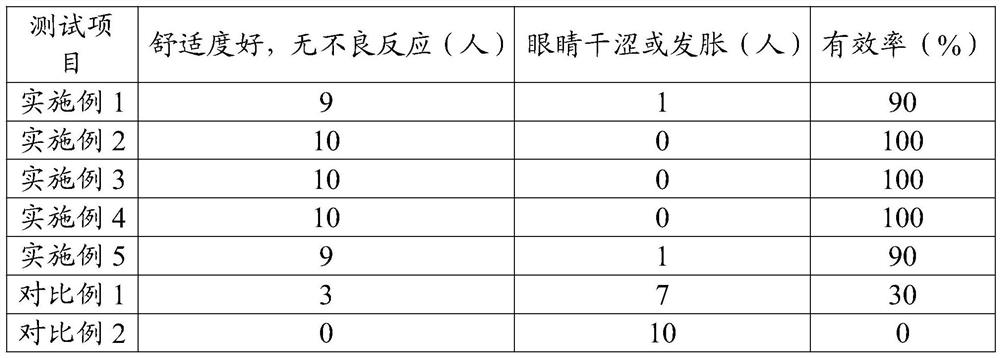Contact lens material, contact lens containing contact lens material and preparation method of contact lens
A technology for contact lenses and raw materials, applied in glasses/goggles, instruments, optics, etc., can solve the problems of hydrogel contact lenses, such as tension, reduced toughness, low moisture content, uncomfortable wearing, etc., to prevent photochemical damage , the effect of increasing moisture content and improving comfort
- Summary
- Abstract
- Description
- Claims
- Application Information
AI Technical Summary
Problems solved by technology
Method used
Image
Examples
Embodiment 1
[0036]Contact lens material, comprising the following raw materials by weight: 70 g of hydroxyethyl methacrylate, 10 g of 2-methacryloyloxyethyl phosphorylcholine, 0.7 g of azophenyl methacrylate, ethylene glycol dimethacrylate 0.3g of ester, 0.25g of 3-(methacryloyloxy)propyltrimethoxysilane, 0.25g of 2-(4-benzoyl-3-hydroxyphenoxy)ethyl 2-acrylate, 0.25g of azobis Isobutyronitrile 0.2g, methacrylic acid 0.2g and sodium hyaluronate 0.1g.
[0037] The preparation method of contact lens is characterized in that, specifically comprises the following steps:
[0038] (1) Weighing raw materials: Weigh each raw material according to the parts by weight of the above-mentioned contact lens materials, mix and stir for 4 hours at a speed of 100 r / min to obtain a contact lens raw material solution, and set aside;
[0039] (2) Making molds:
[0040] A. Making the punch mold: Weigh an appropriate amount of polybutylene terephthalate (English name polybutyleneterephthalate; PBT for short) ...
Embodiment 2
[0047] Contact lens material, comprising the following raw materials by weight: 75 g of hydroxyethyl methacrylate, 15 g of 2-methacryloyloxyethyl phosphorylcholine, 0.7 g of azophenyl methacrylate, ethylene glycol dimethacrylate 0.4g of ester, 0.3g of 3-(methacryloyloxy)propyltrimethoxysilane, 0.25g of 2-(4-benzoyl-3-hydroxyphenoxy)ethyl 2-acrylate, 0.25g of azobis Isobutyronitrile 0.2g, methacrylic acid 0.2g and sodium hyaluronate 0.15g.
[0048] The preparation method of contact lens is the same as embodiment 1.
Embodiment 3
[0050] Contact lens material, including the following raw materials by weight: 77g of hydroxyethyl methacrylate, 20g of 2-methacryloyloxyethyl phosphorylcholine, 0.8g of azophenyl methacrylate, ethylene glycol dimethacrylate 0.4g of ester, 0.5g of 3-(methacryloyloxy)propyltrimethoxysilane, 0.3g of 2-(4-benzoyl-3-hydroxyphenoxy)ethyl 2-acrylate, 0.3g of azobis 0.3g of isobutyronitrile, 0.5g of methacrylic acid and 0.2g of sodium hyaluronate.
[0051] The preparation method of contact lens is characterized in that, specifically comprises the following steps:
[0052] (1) Weighing raw materials: Weigh each raw material according to the parts by weight of the above-mentioned contact lens materials, mix and stir for 5 hours at a speed of 150 r / min to obtain a contact lens raw material solution, and set aside;
[0053] (2) Making molds:
[0054] A. Making the punch mold: Weigh an appropriate amount of polybutylene terephthalate (English name polybutyleneterephthalate; PBT for shor...
PUM
 Login to View More
Login to View More Abstract
Description
Claims
Application Information
 Login to View More
Login to View More - R&D
- Intellectual Property
- Life Sciences
- Materials
- Tech Scout
- Unparalleled Data Quality
- Higher Quality Content
- 60% Fewer Hallucinations
Browse by: Latest US Patents, China's latest patents, Technical Efficacy Thesaurus, Application Domain, Technology Topic, Popular Technical Reports.
© 2025 PatSnap. All rights reserved.Legal|Privacy policy|Modern Slavery Act Transparency Statement|Sitemap|About US| Contact US: help@patsnap.com



